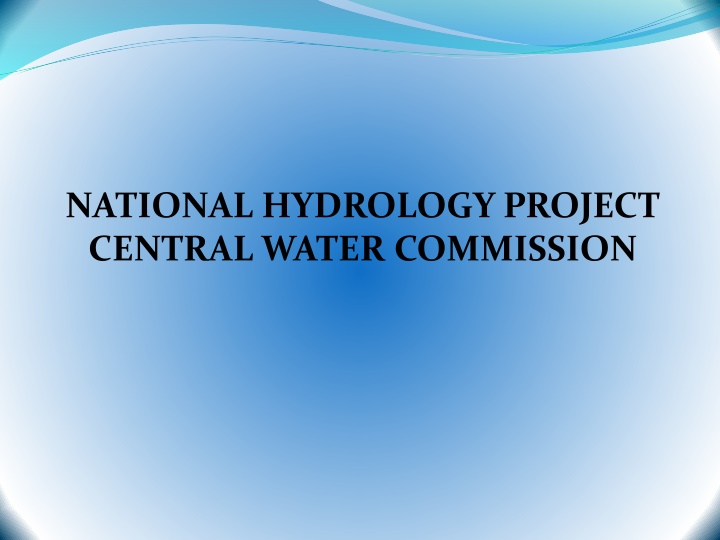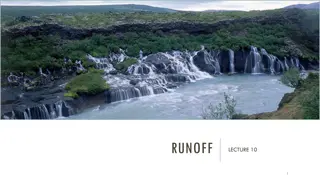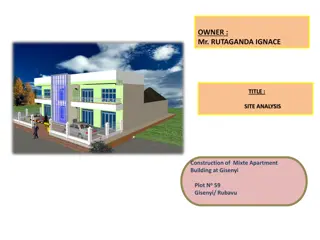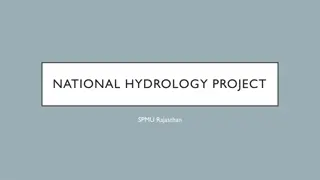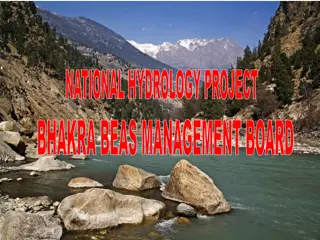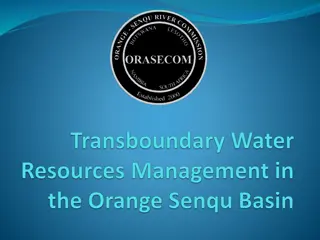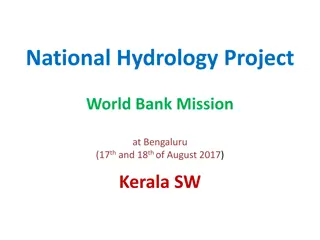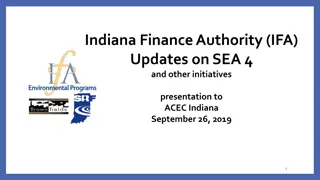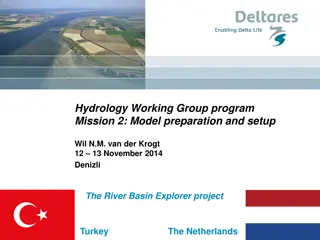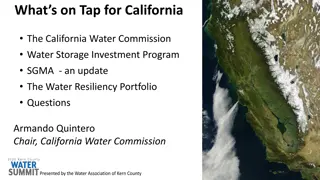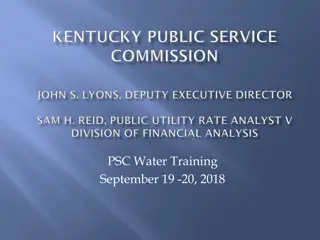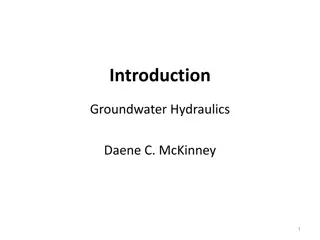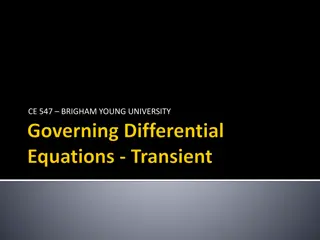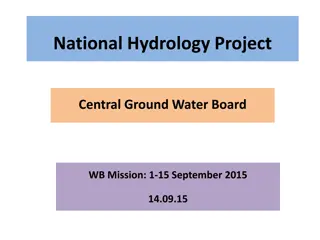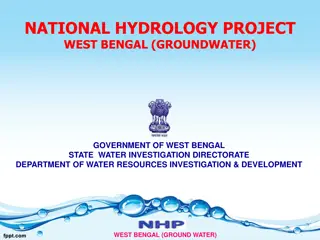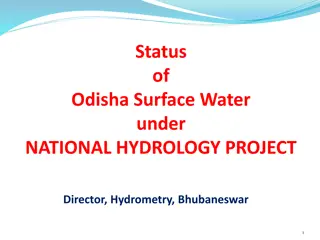National Hydrology Project by Central Water Commission
The National Hydrology Project led by the Central Water Commission focuses on river basin planning, dividing the country into 20 rivers encompassing major and composite basins. The proposed basin studies detail catchment areas, with phases of consultancy involving model development and scenario analysis for water management planning and integration.
Download Presentation

Please find below an Image/Link to download the presentation.
The content on the website is provided AS IS for your information and personal use only. It may not be sold, licensed, or shared on other websites without obtaining consent from the author.If you encounter any issues during the download, it is possible that the publisher has removed the file from their server.
You are allowed to download the files provided on this website for personal or commercial use, subject to the condition that they are used lawfully. All files are the property of their respective owners.
The content on the website is provided AS IS for your information and personal use only. It may not be sold, licensed, or shared on other websites without obtaining consent from the author.
E N D
Presentation Transcript
NATIONAL HYDROLOGY PROJECT CENTRAL WATER COMMISSION
Basin for Study Central water Commission has divided the country into 20 rivers comprising 12 major and 8 composite river basins basins
PROPOSED BASIN STUDY River Basin Catchment area (Sq.Km) Packag e Indus Brahmaputra-Meghna (a) Brahmaputra (b) Barak & others Minor Rivers draining into Myanmar (Burma) and Bangladesh 321289 I II 194413 41723 36302 Godavari Krishna Subernarekha Mahanadi 312812 258948 29196 141589 III IV V
PROPOSED BASIN STUDY River Basin Catchment area (Sq.Km) Package Cauvery Pennar Mahi Sabarmati Narmada Tapi West Flowing Rivers from Tapi to Tadri West Flowing Rivers from Tadri to Kanyakumari East Flowing Rivers between Mahanadi and Pennar East Flowing Pennar&Kanyakumari West Flowing Rivers of Kutch and Saurashtra including Luni 81155 55213 34842 21674 98796 65145 55940 56177 86643 VI VII VIII Rivers between 100139 321851
Period/phases of the Consultancy Phase I- Development of the comprehensive model/ suite of models .-2 year Phase II-Maintenance, updating and Running of the models in real time during warranty period.-2 year
Scope of Consultancy Phase-1 (Development Phase- 2 years) Understand the catchment yield and how this varies in time and space, particularly in response to climate variability: seasonally, inter-annually, and inter-decadally. Estimate the relative contributions of individual catchments to water availability over a much larger region, e.g. valley or basins scale. Estimate how this catchment yield and water availability might change overtime in response to changes in the catchment, such as increasing development of farm dams, or changes inland-use and land management. Development of the comprehensive model/ suite of models for, creation of basin wise plan, including integration of models with input data, creation of dissemination web based GIS portal and dissemination of model output in defined platform. Scenario analysis with climate change impacts for present as well as future Development of Dashboard for IWRM plan and its linkage with existing portals like WRIS, NWIC etc.
Scope of Consultancy Phase-2 (Warranty period- 2 years) 1. Updating models and data as and when required. Addressing problems faced by stakeholders. 2. Debugging of models and dashboards 3. Ensure dissemination of outputs/results to all stakeholders and updation of dashboards if needed. 4. 5. Ensure linkages with existing portals such as WRIS, NWIC etc and with the micro models developed by states in that basin.
Objectives To prepare a long-term Integrated Water Resource Management (IWRM) plan for the river basins, taking into account the State's socioeconomic development plan; To develop both demand management and supply management options, and encourage water-use efficiency through non- regulatory and regulatory mechanisms, particularly to increase efficiency in irrigated and dry land area and engaging the community in the management of the basin's resources, elaborate, monitor and review the River Basin Management Plan so as to; Develop, and update a Water Master Plan through public information and participation; Strategic planning in setting long-term goals for water management in the basins covering management actions, costs and benefits, and risk assessment. issues, priorities,
Objectives Identification of existing and Potential problems in the basins. Facilitation for the formulation of planning and management strategies using the information generated by the Models. Multi-scale environment flow assessment Formulating framework for climate change impact assessment on water resources and adaptation option studies in future Scenario generation Generating problem specific scenarios Capacity building of state government and CWC officials Learning on the job while working with models of their own basin as well as bottom up approach to planning and management in the real sense To establish multi stakeholder engagement processes for strategic basin planning
Benefits/Outcomes Scenarios based on varying efficiencies across sectors, including agriculture water use and industrial water use. Assessment of point and non-point source pollution. Assessment of the Impacts Of climate change on hydrologic extremes of floods and droughts in terms of likely changes in frequencies and magnitudes Assessment of System performance in terms of implications on multi- reservoir systems operation including implications on water sharing among states Options for inter-sectoral water allocations, long term and over-year reservoir operating policies, enhancing water use efficiencies, possible decreases in water demands by adjustments of cropping patterns, conjunctive use of surface and ground waters,enhancing recharge to ground water through artificial recharge, modifications in design requirements of hydraulic structures, change in irrigation practices, Ecological Management Practices (EMP) for sustainable development and any other innovative adaptive responses
Capacity building of state government and CWC officials through o Learning on the job while working with models of their own basin as well as bottom up approach for planning and management in the real sense. o Trainings/Workshops To establish multi stakeholder engagement processes for strategic basin planning Ensure linkages with existing portals such as WRIS, NWIC etc and with the micro models developed by states in that basin. Addressing problems faced by stakeholders. Sharing of Data on real time basis by both state and central Government
Data Requirement Irrigation and cropping areas:- All major and medium project and their area/ command areas(shape file) Time series crops by seasons Time series how much is irrigated with ground water and how much with surface water (by season by crop) Periods of Kharif and Rabi (specific dates) Sowing and harvesting dates of the crops for the different seasons (peak water usage).
Data Requirement Specific of ground water Yield-how many mega liters of water per meter of bore well depth? (with location and time period) Number of ground water pumps in a district Districts areas: Project boundaries in shape file format for the basin/sub-basin Storages/ Barrages Inflow and water levels Daily Elevation - Area Capacity tables [and year of the data] Releases from the dam - from Power house, from Spillway, canals (left and right separately), gates Daily Releases for power (and power generated Kwh), industry, crops urban, etc. Daily Rating curves of canal - head regulators
Hydrodynamic models for Real Time Flood Forecasting coupled with weather forecast including Inundation modeling in Indian rivers
Basin for Study Ganga upto downstream of confluence of Ghagra including all tributaries Tapi and Mahi basin Ganga from d/s confluence of Ghagra upto Farakka (including all tributaries) Subarnarekha &Burhabalanga Brahmaputra upto downstream of confluence of Subansiri including all tributaries Mahanadi (including all tributaries) Brahmaputra d/s of confluence of Subansiri including all tributaries Godavari(including all tributaries)
Scope of the Consultancy Phase I- Development of the comprehensive model/ suite of models for, creation of online inundation map library, real time flood forecasting (level/ Inflow/inundation maps) including integration of models with input data, creation of dissemination web based GIS portal and dissemination of model output in defined platform. (15 months) Phase II- Maintenance, updating and Running of the model in real time during warranty period of 2 years. PhaseIII- Providing updating and Running of the model in real time for period of 3 years after warranty. comprehensive Annual Maintenance,
Objectives of consultancy To develop, calibrate and operate comprehensive model/ suite of models for real time flood forecasting. To create Inundation map library for various return periods of rainfall events/ flood events including different scenarios of embankment breach at identified vulnerable location. To integrate all processes for data management, forecast models and dissemination methodology etc., in a single system in GIS environment to run models and generate forecast in fully automatic mode for short term period (3 days or more)with desired accuracy. To develop web based Integrated Flood Warning System with customized GIS tool for real time dissemination of forecast, inundation map, inundation maps library including development of dashboard for query based generation flood warning/flood inundation maps for all stakeholders. Development of interface for real-time display of results of flood warning system on India-WRIS/ e-SWIS site for disseminating the forecast/inundation maps. Training and Capacity building.
NWIC Modelling centre Model scenarios Model scenarios advisory State Data Centre Modelling Unit Running additional scenarios, if required CWC Regional Modelling Centre
